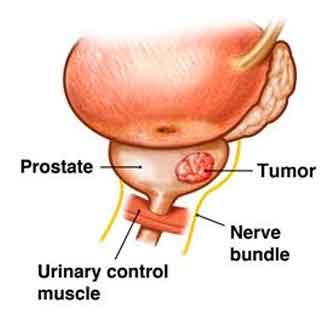- Home
- Editorial
- News
- Practice Guidelines
- Anesthesiology Guidelines
- Cancer Guidelines
- Cardiac Sciences Guidelines
- Critical Care Guidelines
- Dentistry Guidelines
- Dermatology Guidelines
- Diabetes and Endo Guidelines
- Diagnostics Guidelines
- ENT Guidelines
- Featured Practice Guidelines
- Gastroenterology Guidelines
- Geriatrics Guidelines
- Medicine Guidelines
- Nephrology Guidelines
- Neurosciences Guidelines
- Obs and Gynae Guidelines
- Ophthalmology Guidelines
- Orthopaedics Guidelines
- Paediatrics Guidelines
- Psychiatry Guidelines
- Pulmonology Guidelines
- Radiology Guidelines
- Surgery Guidelines
- Urology Guidelines
Active Surveillance of Prostrate Cancer important, says new study

Washington D.C : A recent study shows that doctors suggest to 'wait and see' in thousands of men with localised prostate cancer, where the tumor hasn't spread beyond the doughnut shaped gland.
Every year more than 47,000 British men are diagnosed with the disease, a rise from 35,000 in 2009, reports Daily Mail.
Under NICE guidelines, a wait and see policy is officially called active surveillance and should be offered as a first option when prostate cancer is considered low risk.
This means it is contained in the gland, has a Gleason score below six and the man's PSA test result is below ten.
The Gleason score is a measure of a cancer's aggressiveness (in many cases, prostate cancer grows slowly and never causes a health problem).
The PSA test measures levels of prostate-specific antigen in the blood, raised level in the test can indicate a problem with the prostate, including cancer.
If the patient's levels are rising, it can mean the cancer is growing.
The idea with active surveillance is that the patient is monitored regularly using PSA tests every few months as well as having biopsies and scans when needed.
Earlier also a study published in the New England Journal of Medicine has strengthened the case for active surveillance rather than surgery or radiotherapy.
The decade-long study by UK researchers found men with early stage prostate cancer have just as good a chance of being alive after ten years as men who have treatments, including surgery and radiotherapy, which can have unpleasant and sometimes permanent side-effects, including loss of sexual function and incontinence.
According to the charity Prostate Cancer in UK, 30 percent of men eligible for active surveillance choose it after advice from their doctors, but it could soon be many more.
An expert in the field Professor Roger Kirby, agrees that active surveillance is important in helping men with early stage prostate cancer, particularly older men with a shorter life expectancy and those with serious health conditions.
However pointing out his significant caveats, he said "You have to be confident you don't miss the window of opportunity to treat prostate cancer that is progressing. The NHS has guidelines that should help to ensure any changes are spotted, but standards can vary greatly."
According to guidelines, men under active surveillance should undergo PSA testing every three to four months in the first year, then every three to six months for the next three years.
hey should also have a biopsy after 12 months.
From the fifth year, PSA should be measured every six months. The patient may also be given a digital rectal examination once a year.
After the start of active surveillance, when an MRI should be performed, there is no requirement for further scans unless symptoms change.
"We don't know if the system is robust enough and working well everywhere. The guidance is there, but might not always be followed. We know of men who have moved house and dropped off the NHS radar, only to find their cancer has spread," said expert Matthew Hobbs.
Professor Chris Eden said the complications from the treatment may also have been overplayed.
"Forty percent of my patients have erectile dysfunction before treatment for prostate cancer. In other words, a complication from treatment may be a pre- existing condition," he said.
Incontinence following surgery is usually temporary. Robert, who has five children and underwent this type of treatment said he had minimal problems after four months of hormone therapy and radiotherapy.
"I developed man boobs during the hormone injections, but they went away," he said.
He has osteoporosis as a result of hormone therapy and suffers "aches and pains, but it was worth it for the peace of mind. Active surveillance can mean you are on edge waiting for the next test results."
Professor Kirby believes active surveillance will be more widely used, but said "the only people who should be offered it are those who are genuinely low-risk not all localised prostate cancer is low-risk."
'In fact, it may be an aggressive form of tumour. I'm not confident the NHS has accurate enough ways to tell the difference," he added.
New genetic tests make it easier to identify aggressive early stage cancers. Prolaris, which tests for 46 genes, has been shown in studies to accurately predict the aggressiveness of a patient's prostate tumour in conjunction with Gleason scores and PSA tests.
Kirby points out that men who are advised not to have treatment but go on to develop terminal prostate cancer might sue their doctors.

Disclaimer: This site is primarily intended for healthcare professionals. Any content/information on this website does not replace the advice of medical and/or health professionals and should not be construed as medical/diagnostic advice/endorsement or prescription. Use of this site is subject to our terms of use, privacy policy, advertisement policy. © 2020 Minerva Medical Treatment Pvt Ltd